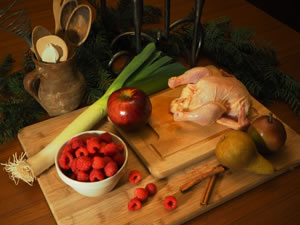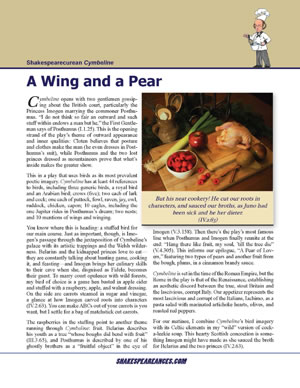Cymbeline
A Wing and a Pear
Cymbeline opens with two gentlemen gossiping about the British court, particularly the Princess Imogen marrying the commoner Posthumus. “I do not think so fair an outward and such stuff within endows a man but he,” the First Gentleman says of Posthumus (I.1.25). This is the opening strand of the play's theme of outward appearance and inner qualities: Cloten believes that posture and clothes make the man (he even dresses in Posthumus's suit), while Posthumus and the two lost princes dressed as mountaineers prove that what's inside makes the greater show.
This in a play that uses birds as its most prevalent poetic imagery. Cymbeline has at least 44 references to birds, including three generic birds, a royal bird and an Arabian bird; crows (five); two each of lark and cock; one each of puttock, fowl, raven, jay, owl, ruddock, chicken, capon; 10 eagles, including the one Jupiter rides in Posthumus's dream; two nests; and 10 mentions of wings and winging.
 You know where this is heading: a stuffed bird for our main course. Just as important, though, is Imogen's passage through the juxtaposition of Cymbeline's palace with its artistic trappings and the Welsh wilderness. Belarius and the kidnapped princes love to eat—they are constantly talking about hunting game, cooking it, and feasting—and Imogen brings her culinary skills to their cave when she, disguised as Fidele, becomes their guest. To marry court opulence with wild forests, my bird of choice is a game hen basted in apple cider and stuffed with a raspberry, apple, and walnut dressing. On the side are carrots steamed in sugar and vinegar, a glance at how Imogen carved roots into characters (IV.2.63). You can make ABCs out of your carrots is you want, but I settle for a bag of matchstick cut carrots.
You know where this is heading: a stuffed bird for our main course. Just as important, though, is Imogen's passage through the juxtaposition of Cymbeline's palace with its artistic trappings and the Welsh wilderness. Belarius and the kidnapped princes love to eat—they are constantly talking about hunting game, cooking it, and feasting—and Imogen brings her culinary skills to their cave when she, disguised as Fidele, becomes their guest. To marry court opulence with wild forests, my bird of choice is a game hen basted in apple cider and stuffed with a raspberry, apple, and walnut dressing. On the side are carrots steamed in sugar and vinegar, a glance at how Imogen carved roots into characters (IV.2.63). You can make ABCs out of your carrots is you want, but I settle for a bag of matchstick cut carrots.
The raspberries in the stuffing point to another theme running through Cymbeline: fruit. Belarius describes his youth as a tree “whose boughs did bend with fruit” (III.3.65), and Posthumus is described by one of his ghostly brothers as a “fruitful object” in the eye of Imogen (V.3.158). Then there's the play's most famous line when Posthumus and Imogen finally reunite at the end: “Hang there like fruit, my soul, 'till the tree die” (V.4.305). This informs our dessert, “A Pear of Lovers,” featuring two types of pears and another fruit from the bough, plums, in a cinnamon brandy sauce.
Cymbeline is set in the time of the Roman Empire, but the Rome in the play is that of the Renaissance, establishing an aesthetic discord between the true, stout Britain and the lascivious, corrupt Italy. Our appetizer represents the most lascivious and corrupt of the Italians, Iachimo, as a pasta salad with marinated artichoke hearts, olives, and roasted red peppers.
For our matinee, I combine Cymbeline's bird imagery with its Celtic elements in my “wild” version of cock-a-leekie soup. This hearty Scottish concoction is something Imogen might have made as she sauced the broth for Belarius and the two princes (IV.2.63).Eric Minton
December 14, 2017
PRINCES' GAME HENS
2 Rock Cornish Game Hens
1/2 gallon apple cider
1 stalk of celery
1 small onion
6 tablespoons butter
1/2 loaf French baguette of bread
1 large apple
1/4 cup currants
1/2 cup chopped walnuts
1 teaspoon nutmeg
1 cup raspberries
(1/4 cup apple cider from the marinade)
-
Thaw the hens and soak them in apple cider up to 24 hours. [Soaking the hens overnight allows them to absorb the apple cider, making for a more succulent, tender meat.]
-
Chop the celery and onions. Melt the butter over medium-high heat and sauté the celery and onions until tender. Set aside.
-
Cut the bread into small cubes (slice quarter inch, then three cross-slices in each axis on the slices). Place the bread into a large bowl. [Some people might prefer larger chunks of bread, but we found that the smaller pieces make for a more consistently uniform stuffing, bonding all the ingredients—the apples, currants, and walnuts.]
-
Chop the apple and add to the bread. Add in the currants, walnuts, nutmeg, and the onion/celery/butter. Stir thoroughly until all the bread is soaked in the butter.
-
Stir in 1/4 cup of the cider marinating the hens.
-
Gingerly, stir in the berries.
-
Preheat the oven to 350 degrees Fahrenheit.
-
Stuff the hens. Roast the stuffed hens, basting every 20 minutes with the apple cider marinade, for about two hours (internal temperature of the hens should be 165 degrees Fahrenheit). [Roasting time depends on the oven and size and number of hens. You can start gauging the temperature at the fifth point of basting (1:40 into the roasting). At 165 degrees Fahrenheit you get a perfectly succulent hen; the higher the temperature, the dryer the meat.]
-
Place the remainder of the stuffing in a covered casserole dish and place in the oven an hour into the hens cooking.
Servings: Two hens or four half-hens, with enough stuffing for leftovers (not only for another dinner, but breakfast, too).
FIGURED ROOTS
5 ounces of matchstick carrots
1 tablespoon brown sugar
2 tablespoons apple cider vinegar
-
Place the carrots in a saucepan. Mix the brown sugar and apple cider vinegar and add to the carrots, stirring to coat them thoroughly.
-
Turn on the heat and bring the liquid to a slight boil to steam the carrots about 15 minutes.
PROLOGUE: IACHIMO'S PASTA SALAD
2 large red peppers
Olive oil
1 cup pitted Italian castelvetrano olives
12 ounces artichoke hearts [The best option for the artichokes, we have found, is the unseasoned marinated version in the supermarket olive bar; failing to find that, you can use canned or jarred artichokes.]
1 pound of pasta twists (Rotini or Fusilli)
Salt
For the dressing:
2 sprigs rosemary (about 1 tablespoon chopped)
10 leaves basil (about 1 tablespoon chopped)
15 chive stalks (about 1 tablespoon chopped)
10 sprigs thyme (about 1 tablespoon leaves)
1 clove garlic
1/4 cup white wine vinegar
3 tablespoons water
1/2 cup olive oil
-
Roast the red peppers. Preheat the oven to 350 degrees Fahrenheit. Cut out the stems, slice peppers in half, clear out the pulp and seeds, and place on aluminum foil on a baking sheet. Lightly brush on some olive oil. Roast for about 45–60 minutes until the skins start turning black. Remove from the oven and close up the foil to create a pouch containing the peppers. Allow them to cool a little.
-
Prepare the dressing. Chop the rosemary and basil, snip the chives, and pick the thyme leaves from their stalks. Press the garlic. Combine the vinegar and water in a jar or cruet, add in the herbs and shake well. Add in the olive oil and shake well. You will only use 1/2 cup. [Leaving the thyme leaves whole enhances their flavor. You can chop the garlic if you don't have a press.]
-
Back to the red peppers: peel the skin off and discard; chop the red pepper meat. Chop the olives. Slice the artichoke hearts in half.
-
Fill a kettle with water for the pasta. Sprinkle in salt and bring the water to a boil. Add in the pasta and cook to al dente. Drain. Return the pasta to the kettle or place it in a bowl.
-
Stir in 1/2 cup of the dressing and coat the pasta thoroughly. Stir in the red peppers and the chopped olives. Stir in the artichokes.
-
Can be served hot, cold or, best of all, at room temperature.
Servings: Six; the leftovers improve with time, good for lunches or as a salad for subsequent meals.
The dressing seems like a lot of work when you end up using only a half cup, but the proportions don't work if you try to reduce the amounts. Rather, make the dressing for this dish but use the rest of it as a salad dressing or meat and vegetable marinade. As this version is heavy on the herbs for its purpose in this recipe, to better balance it as a typical dressing, add to the leftovers 1/8 cup white wine vinegar, 1 1/2 tablespoons water, and 1/4 cup olive oil.
EPILOGUE: PEAR OF LOVERS
2 pears, two different types
2 plums
1/2 cup brandy
1/2 teaspoon cinnamon
1/2 cup oats
Stick of cinnamon
Heavy cream
-
Peel the pears and chop. Place in a saucepan.
-
Peel the plums and chop. Stir in with the pears.
-
Stir in the brandy and cinnamon.
-
Place over medium-high heat and cook about 20 to 30 minutes.
-
Stir in the oats.
-
Preheat the oven to 350 degrees Fahrenheit.
-
Transfer the pears into individual-sized casserole dishes or tart pans. Break the cinnamon stick and place a portion into each dish, like a branch sticking out of the pears and plums.
-
Bake for about 15 minutes.
-
Remove, drizzle a little cream over the top, and serve.
Servings: Two tart dishes.
MATINEE: WILD COCK-A-LEEKIE SOUP
4 leeks
8 tablespoons butter
1/4 cup olive oil
6 thigh chicken cutlets
1/2 cup flour
96 ounces chicken stock
1 cup white wine [Use a good but inexpensive wine that you would drink (not “cooking wine”), preferably one with a simple palate: a Pinot Grigio or table wine.]
1 cup pitted prunes (about 35 pitted prunes)
1 cup uncooked wild rice
1 pint heavy cream
- Chop the leaks, discarding the tough green tops, and thoroughly rinse under running water. [Put the chopped leeks into a large colander and place in a deep bowl or pot. Fill with water until it rises into the colander and the leeks are able to move freely when you swirl your hand through the water. Drain by lifting the colander out of the pot, pour the water out of the pot, and repeat as necessary to clean the leeks.]
- Trim the excess skin and fat from the chicken thighs and dice the meat into small pieces.
- In a stockpot, place the olive oil and the stick of butter, melting over medium-high heat.
- Sauté the leeks in the pot until tender.
- Add the chicken to the pot.
- Scatter in the flour. Stir to coat the chicken and continue cooking until the chicken is no longer pink and starting to brown. [This step is about thickening the soup and richness, not merely coating the chicken; in other words, don't think you can save some trouble by shake-and-baking the chicken with the flour. If your pot is not nonstick, you will have to diligently stir the chicken/leeks/flour as they brown to keep the ingredients from sticking to the bottom of the pot.]
- Pour in the stock and wine. Bring to a boil.
- Meantime, dice the prunes into tiny pieces and add to the soup.
- Add in the rice, return to a boil, then lower the heat to simmer and cook for an hour or two.
- Before serving, stir in the cream.
Servings: About 12 two-cup servings. This is a big pot of soup that not only is great for days to come but, frozen in single-serving containers, becomes an easy-to-pack lunch or pop-in-the-microwave meal.
Soup is best when it ages a day, so you could prepare this the day before you intend to serve it.
Wine Pairing
This dinner moves through so many different flavors that you need either a wine for each course or one wine that pairs well with one course and stands up to the rest. You can go white, red, or rosé. The white of choice is an Italian Gewürztraminer. A drier version of the grape and not overly sweet as German Gewürtzes tend to be, the Italian Gewürztraminer pairs especially well with the Iachimo Pasta Salad and the Figured Roots, suitably accompanies the hen and stuffing, and creates wonders with the Pear of Lovers. The St. Paul's Justina Gewürztraminer is suitable in name—combining the play's Lud's Town and Rome settings—as well as in quality, and the Terlan Gewüztraminer is as complex as Cymbeline itself. Among reds, a pinot noir is the best pairing, standing up to all the flavors and pairing beautifully with the hen. A suitable thematic choice is a Louis Latour Nuits St. Georges from France. Though the play is set in Britain and Rome, Gaul and France is an oft-mentioned traverse point key to both the wager plot and the Roman invasion. A less expensive and still thematic alternative would be an Italian pinot noir, such as a St. Paul's Luzia. As with most stuffed fowl, a rosé can make a good pairing, but aim for a Province variety, such as Domaine la Rabiotte or a Chateau de Libran, that will stand up to this menu's variety of flavors.
Comment: e-mail editorial@shakespeareances.com




 Find additional Shakespeareances
Find additional Shakespeareances